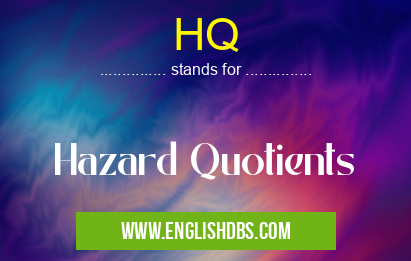What does HQ mean in UNCLASSIFIED
HQ stands for Hazard Quotients, representing the ratio of the estimated exposure to a chemical substance to a safe or acceptable level of exposure. It's commonly used in risk assessment to gauge the potential health effects associated with exposure to hazardous materials.

HQ meaning in Unclassified in Miscellaneous
HQ mostly used in an acronym Unclassified in Category Miscellaneous that means Hazard Quotients
Shorthand: HQ,
Full Form: Hazard Quotients
For more information of "Hazard Quotients", see the section below.
What does HQ Mean?
HQ values indicate the likelihood and severity of adverse effects resulting from exposure to a specific chemical. They are calculated by comparing the estimated exposure concentration to a reference value, such as a regulatory limit or a tolerable daily intake (TDI).
How are HQs Calculated?
HQs are typically calculated using the following formula:
HQ = Estimated Exposure Concentration / Reference ValueInterpretation of HQs
- HQ < 1: Exposure is below the safe or acceptable level, indicating minimal or no risk.
- HQ = 1: Exposure is equal to the safe or acceptable level, suggesting potential for adverse effects.
- HQ > 1: Exposure exceeds the safe or acceptable level, indicating a higher likelihood of adverse health effects.
Uses of HQs
HQs play a crucial role in:
- Assessing the health risks associated with exposure to chemicals in the environment, workplace, and consumer products.
- Prioritizing chemicals for regulatory action based on their potential hazards.
- Setting exposure limits and guidelines to protect human health.
- Evaluating the effectiveness of risk management strategies.
Essential Questions and Answers on Hazard Quotients in "MISCELLANEOUS»UNFILED"
What are Hazard Quotients (HQs)?
Hazard Quotients (HQs) are numerical values used to assess the potential for adverse health effects from exposure to hazardous substances. They are calculated by dividing the estimated exposure dose by a reference dose or concentration that is considered safe.
How are HQs used?
HQs can be used to:
- Prioritize chemicals for risk management
- Evaluate the potential for health hazards from environmental exposures
- Set regulatory limits for exposure to chemicals
What is a safe HQ?
Generally, an HQ below 1 indicates that the potential for adverse health effects is considered low. However, HQs should be interpreted in the context of other factors, such as the toxicity of the chemical, the duration of exposure, and the health of the exposed population.
What is the difference between HQ and Risk Characterization Ratio (RCR)?
HQs are used for single chemicals, while RCRs are used to assess the combined risk from multiple chemicals in a mixture. RCRs are calculated by summing the HQs for all chemicals in the mixture.
How are HQs calculated? A: HQs are calculated using the following formul
HQs are calculated using the following formula:
HQ = Estimated Exposure Dose / Reference Dose or ConcentrationThe estimated exposure dose is derived from monitoring data, modeling, or other methods.
Final Words: HQs serve as valuable tools in risk assessment, providing insights into the potential health effects of exposure to hazardous chemicals. They help regulators, industry professionals, and the public make informed decisions about managing chemical risks and protecting human health.
